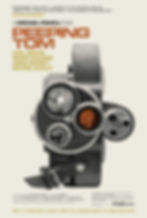Peeping Tom 1960 Movie Poster
- Allan Major
- Jun 8, 2024
- 3 min read

The poster for the 1960 horror-thriller film "Peeping Tom," directed by Michael Powell, is a striking piece that effectively conveys the film's unsettling themes and psychological depth. The minimalist design and focus on the camera as a central motif highlight the film's exploration of voyeurism and the dangers of obsession.
Visual Elements
The central image of the poster is an old-fashioned film camera, with the lenses reflecting distorted and fearful faces. This camera is not just a tool for capturing images but a symbol of the protagonist's disturbed psyche and his voyeuristic tendencies. The close-up view of the camera emphasizes its importance in the film, where it serves as both a weapon and a window into the protagonist's mind.
The faces within the camera's lenses are distorted, with expressions of terror and shock. These images hint at the film's themes of voyeurism and the psychological horror experienced by the victims. The use of black and white for the camera, contrasted with the sepia-toned faces, adds a timeless and eerie quality to the poster, reinforcing the film's haunting nature.
The background is kept simple and light, ensuring that the focus remains on the camera and the faces within it. This minimalist approach draws the viewer's attention directly to the central elements and the psychological tension they represent.
Typography and Title Design
The title "Peeping Tom" is prominently displayed in large, bold orange letters just above the camera. The font is clean and modern, contrasting with the vintage camera and creating a juxtaposition between the old and the new, the observed and the observer. The color orange adds a sense of urgency and intensity, making the title stand out against the otherwise muted background.
Above the title, the text "A Michael Powell Film" is presented in a smaller, black font, emphasizing the director's name and linking the film to his reputation and previous works. This adds an element of prestige and curiosity, as Michael Powell was known for his innovative and often controversial films.
A quote from Martin Scorsese at the top of the poster praises the film, adding a layer of credibility and drawing in viewers who respect Scorsese's opinion. This endorsement helps to position the film as a significant and influential work in the genre.
The cast list, featuring Carl Boehm, Moira Shearer, Anna Massey, and Maxine Audley, is presented in a straightforward, yellow font below the title. This ensures that the focus remains on the visual elements while still providing important information about the film's stars.
Contextual Background
"Peeping Tom" is a psychological thriller that follows the story of Mark Lewis (Carl Boehm), a young man who works as a focus puller at a film studio and moonlights as a photographer of pin-up models. Mark is also a serial killer who films his victims' final moments of terror. The film explores themes of voyeurism, obsession, and the dark side of human nature.
Directed by Michael Powell, "Peeping Tom" was initially met with harsh criticism for its disturbing content and was considered controversial at the time of its release. However, it has since been re-evaluated and is now regarded as a classic, influential in the psychological horror genre.
Conclusion
The poster for "Peeping Tom" is a masterful example of minimalist design that effectively conveys the film's psychological depth and disturbing themes. The central image of the camera, with its distorted, terrified faces, captures the essence of the film's exploration of voyeurism and obsession. The use of a simple background and bold typography ensures that the focus remains on the key elements, creating a sense of tension and intrigue.
By highlighting Michael Powell's involvement and including a quote from Martin Scorsese, the poster adds layers of credibility and appeal, drawing in viewers who appreciate cinematic history and psychological horror. This poster not only serves as an enticing promotional tool but also stands as a piece of art that reflects the enduring impact of "Peeping Tom." It invites viewers to delve into the dark, voyeuristic world of the film and experience its unsettling power.




